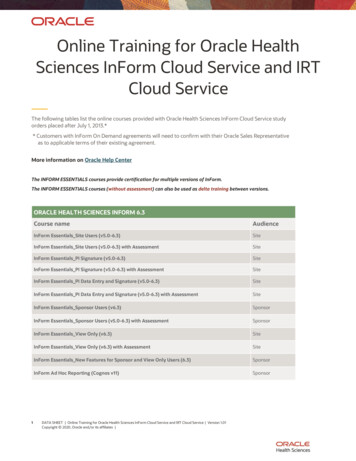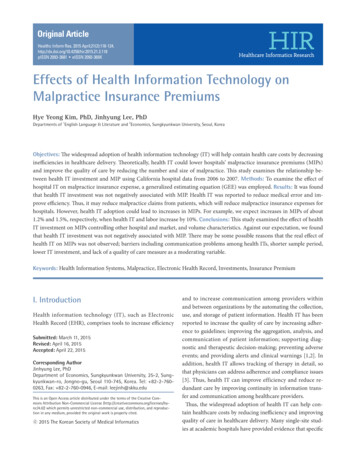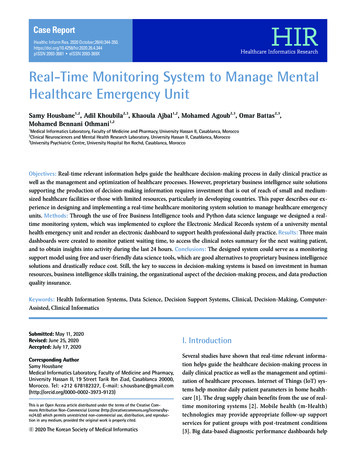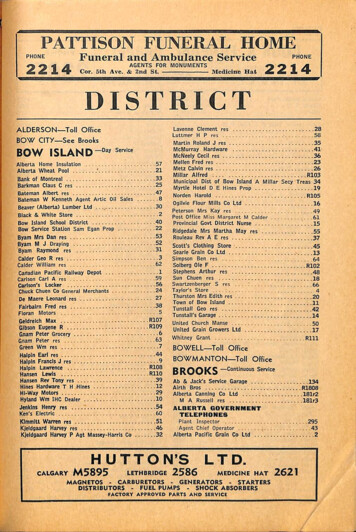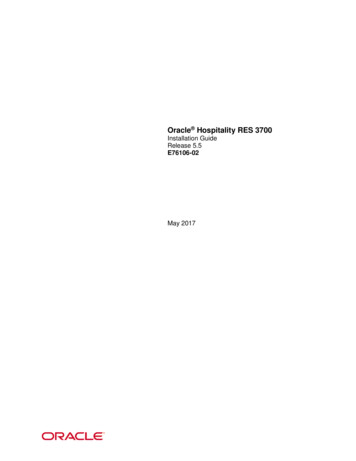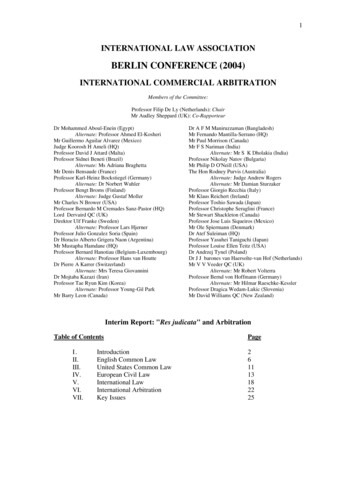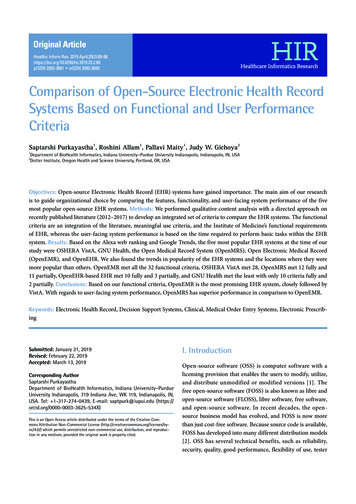
Transcription
Original ArticleHealthc Inform Res. 2019 .25.2.89pISSN 2093-3681 eISSN 2093-369XComparison of Open-Source Electronic Health RecordSystems Based on Functional and User PerformanceCriteriaSaptarshi Purkayastha1, Roshini Allam1, Pallavi Maity1, Judy W. Gichoya21Department of BioHealth Informatics, Indiana University–Purdue University Indianapolis, Indianapolis, IN, USADotter Institute, Oregon Health and Science University, Portland, OR, USA2Objectives: Open-source Electronic Health Record (EHR) systems have gained importance. The main aim of our researchis to guide organizational choice by comparing the features, functionality, and user-facing system performance of the fivemost popular open-source EHR systems. Methods: We performed qualitative content analysis with a directed approach onrecently published literature (2012–2017) to develop an integrated set of criteria to compare the EHR systems. The functionalcriteria are an integration of the literature, meaningful use criteria, and the Institute of Medicine’s functional requirementsof EHR, whereas the user-facing system performance is based on the time required to perform basic tasks within the EHRsystem. Results: Based on the Alexa web ranking and Google Trends, the five most popular EHR systems at the time of ourstudy were OSHERA VistA, GNU Health, the Open Medical Record System (OpenMRS), Open Electronic Medical Record(OpenEMR), and OpenEHR. We also found the trends in popularity of the EHR systems and the locations where they weremore popular than others. OpenEMR met all the 32 functional criteria, OSHERA VistA met 28, OpenMRS met 12 fully and11 partially, OpenEHR-based EHR met 10 fully and 3 partially, and GNU Health met the least with only 10 criteria fully and2 partially. Conclusions: Based on our functional criteria, OpenEMR is the most promising EHR system, closely followed byVistA. With regards to user-facing system performance, OpenMRS has superior performance in comparison to OpenEMR.Keywords: Electronic Health Record, Decision Support Systems, Clinical, Medical Order Entry Systems, Electronic PrescribingSubmitted: January 21, 2019Revised: February 22, 2019Accepted: March 13, 2019Corresponding AuthorSaptarshi PurkayasthaDepartment of BioHealth Informatics, Indiana University–PurdueUniversity Indianapolis, 719 Indiana Ave, WK 119, Indianapolis, IN,USA. Tel: 1-317-274-0439, E-mail: saptpurk@iupui.edu (https://orcid.org/0000-0003-3625-534X)This is an Open Access article distributed under the terms of the Creative Commons Attribution Non-Commercial License (http://creativecommons.org/licenses/bync/4.0/) which permits unrestricted non-commercial use, distribution, and reproduction in any medium, provided the original work is properly cited.2019 The Korean Society of Medical InformaticsI. IntroductionOpen-source software (OSS) is computer software with alicensing provision that enables the users to modify, utilize,and distribute unmodified or modified versions [1]. Thefree open-source software (FOSS) is also known as libre andopen-source software (FLOSS), libre software, free software,and open-source software. In recent decades, the opensource business model has evolved, and FOSS is now morethan just cost-free software. Because source code is available,FOSS has developed into many different distribution models[2]. OSS has several technical benefits, such as reliability,security, quality, good performance, flexibility of use, tester
Saptarshi Purkayastha et al1. Information Source and SearchRelevant articles on open-source EHR systems were identified primarily using Scopus. We also used other databases,such as PubMed and IEEE Xplore, to ensure that we wouldnot leave out any publications that are not indexed by Scopus. We searched publications from 2012 to 2017 to identifycriteria to compare open-source EHR systems. Only Eng-90www.e-hir.org2. Study Selection, Data Collection Process, and DataItemsThe next step was a detailed examination of papers andexclusion of irrelevant papers. We included articles that discussed ‘open-source electronic health record systems’ AND‘comparison’ OR ‘adoption’ OR ‘utilization’ OR ‘analysis’ OR‘application’. Figure 1 presents the PRISMA flowchart outlining the process for systematic review. Only full-text availablearticles were selected. Finally, we included a total of 25 articles.ScreeningIdentification3. Literature ReviewA study conducted by Zaidan et al. [6], evaluated variousopen-source EHR systems using multi-criteria decisionmaking of AHP-TOPSIS, which is complicated and requiresan enterprise-wide understanding of the concept of an idealsolution. To assess OSS EHR functionality, we consideredthe following eight parameters: health information and data,results management, order entry and management, decisionsupport, electronic communication and connectivity, patientsupport, administrative processes, and reporting and population health management. This is based on the Instituteof Medicine (IOM), renamed as the National Academy ofMedicine’s eight-core features of an EHR system.Goldwater et al. [7] studied the use of open-source EHRsystems in chronic disease management. The study showedthe positive impact of an open-source EHR system in im-EligibilityII. Methodslish language articles were selected. The search terms werelooked up in their titles and abstracts.Includedand user base, compatibility, and harmonization [3]. FOSS inhealthcare is different because of the inherent need for domain-specific experts in the community. From 1999 to 2001,the healthcare industry saw the start of many OSS projects[4]. Several factors have contributed to the success of software products in healthcare. These include the existence of auser community and a developer community, regular releasecycles, modular architecture, documentation of software,and support services [4].One of the most significant benefits of OSS in the healthcare industry is that FOSS is easy to obtain as it can bedownloaded easily from repositories. There are no restrictive licensing terms regarding distribution, derivative works,or modifications, and there are no software licensing fees.Open-source software is vendor neutral, which means thatorganizations or individuals do not suffer from vendorlock-in. Although there are numerous other benefits of costsavings and flexibility, opportunities to innovate while remaining independent from vendors is more applicable tohealthcare [3].Challenges of OSS in healthcare are organizational in nature, such as long-term support organization, funding andownership for EHR certification, open-source businessmodels, medical informatics and domain specific issues,functionality-based limitations, usability issues, challengesin resource-restricted environments, and challenges relatedhuman factors [5]. The main objective of this work is toguide organizational choice to select an open-source systemfor implementation by comparing the features and functionality of the five most popular open-source Electronic HealthRecord (EHR) systems using an integrated set of criteria. Itmight also provide useful insight for open-source developersto identify the functional requirements that are missing butrequired by clinical users. The user performance comparison results may be used by EHR developers to analyze andimprove the usability of their products for basic tasks, suchas patient search, ordering, viewing patient records, and soforth.Titles and abstrats retrieved form search (n 133)Scopus (n 81); IEEE Xplore (n 20); PubMed (n 32)Duplicates (n 55)Full-text articles obtained(n 78)Studies excluded upon furtheranalysis (n 53)Studies included in the review(n 25)Figure 1. PRISMA flowchart outlining the process of 25.2.89
Comparison of Open-Source EHR Systemsproving diabetes and tuberculosis management and controlling hypertension. They identified six essential elements thatshould be available in an EHR system to support chronicdisease management. These elements include modern clinical information services, systematic decision support systems, self-management support for patients, and links tocommunity resources [7]. Meaningful use criteria includeclinical decision support and availability of patient-specificresources; therefore, we included them in our integratedfunctional criteria [8].Based on the results of the qualitative content analysiswe selected meaningful use criteria and the eight-corefunctionalities from the IOM, finally totaling 32 criteria tocompare the features and functionalities of various healthFOSS. We adopted a set of performance criteria from thestudy conducted by de Abajo and Ballestero [9] to compareOpenMRS, OpenEMR, and VistA. Along with the literature,we thoroughly reviewed all the software documentation onthe websites of the five EHR systems.List of open-source EHRsystems packagesSelection of top fiveopen-source EHR systems4. Comparison CriteriaThe study was conducted as follows. The open-sourceEHR systems were compared using a set of performancemeasuring parameters by deploying the software on a localmachine. Then they were compared in terms of meaningfuluse criteria and the IOM core functionalities. Figure 2 showsan overview of the methodology.1) Identification and selection of open-source EHR systemsThe open-source EHR systems were selected in two steps.The top five EHR systems were selected based on theirglobal website ranking and identification of the reach andpopularity of open-source EHR systems over time. Alexa isa global ranking system that utilizes web traffic data to compile rankings. From the 15 listed open-source EHR systems(See Table 1), VistA, GNU Health, OpenMRS, OpenEMR,and OpenEHR were selected based on their global rankingsretrieved from Alexa rank. HOSxP changed its license in2015, and we excluded it from our study due to its focus ona subscription-based hosted EHR. These five EHR systemsDesigning set of criteria tocompare EHR systemsComparing the EHR systems usingperformance, meaningful use criteriaand core functionalitiesFigure 2. Flowchart illustrating themethods of the current study.EHR: Electronic Health Record.Table 1. List of open-source EHR systems along with the official website and its global rankEHR systemLinkGlobal rankVistA (OSHERA)http://www.ehealth.va.gov4,052GNU ,913CARE2X systemhttp://care2x.org4,314,882Hospital No global rankZEPRShttp://www.ictedge.org/projects/zeprsNo global rank407,971EHR: Electronic Health Record.Vol. 25 No. 2 April 2019www.e-hir.org91
Saptarshi Purkayastha et alvary greatly regarding their audience and the type of healthfacility that they target. However, we compared the clinicalfeatures that should be present in all EHR systems, irrespective of whether they are implemented in a primary care clinic, community hospital, or a tertiary hospital, even thoughthe sophistication of those functionalities might differ basedon needs. OpenEHR is a standard, a set of archetypes thatare implemented in EHR system products. OSEHRA VistAand GNU Health are hospital information systems. OpenEMR and OpenMRS are EHR systems or platforms, respectively, but those are details that are common across proprietary EHR systems, which market their products to differentaudiences and focus on certain types of clinical settings. AGoogle Trends comparison of the five selected EHR systemsfrom August 2017 to August 2018 is shown in Figure 3.Figure 4 shows the regional popularity of each of thefive EHR systems. It is interesting to note that OpenEHRis clearly more popular in Northern European countries,Scandinavia, Brazil, and Australia than the rest of the world.GNU Health has some interest in China, the US, Argentina,Germany, and Spain. OpenEMR and OpenMRS have moreglobal reach, and this can also be identified by considerationof the global implementation map of these EHR systems.OpenMRS is clearly very popular and widely implementedin Africa, India, and South East Asia. OpenEMR has implementations in India, the United States, Brazil, the UK, andSouth Korea. VistA is primarily used by the Veterans Affairs(VHA) in the United States, with some custom implementations and distributions of it in other places.2) EvaluationThe evaluation in our study was carried out in two mainphase, one by deploying the software and comparing theEHR systems using the standard set of criteria, and subsequently by comparing the performance parameters.(i) Deploying each open-source EHR software: Documentation available on respective EHR system official websiteswere used for deployment.(ii) Establishing criteria to evaluate and compare: Based onthe literature review summarized above, using qualitativecontent analysis, we developed an evaluation criterionextracted from the meaningful use criteria and eight-GNU HealthOpenEMROpenEHROpenMRSVistA EHRSearch termSearch termSearch termSearch termSearch termWorldwide01/08/2017-31/08/2018All categoriesWeb SearchInterest over time ? 100755025Average6 Aug 2017GNU HealthOpenEMR13 May 201824 Dec 2017OpenEHROpenMRSFigure 3. Comparison of interest overtime (August 2017 to August 2018) for the five EHRsystems. EMR: ElectronicMedical Record, EHR: Electronic Health Record, MRS:Medical Record System.VistA EHRFigure 4. Interest of the five selectedEHR systems by region. EMR:Electronic Medical Record,EHR: Electronic Health Record, MRS: Medical 8/hir.2019.25.2.89
Comparison of Open-Source EHR Systemscore functionalities listed by the IOM [10].OpenMRS stores all of a patient’s details, visits, encounters,and observations.3) Performance criteriaThe selected parameters of user performance criteria includeinitial CPU use, startup time of the server, shutdown timeof server, login time and CPU use, patient search time andCPU use, time for creating new patient and CPU use, timefor change of patient and CPU use, average navigation timefor the main menu and CPU use, logout time and CPU use.These performance criteria were implemented on a machinewith a 64-bit Windows 10 operating system and 8 GB RAM.III. ResultsThe interoperability comparison focused on criteria basedon meaningful use presented in Table 2.1. Transition of Care and Clinical InformationReconciliationZH Healthcare incorporated a mechanism to upload, process, display, and incorporate CCDA into OpenEMR. In OSEHRA VistA, this criterion is fulfilled by popHealth, whichis an open-source quality measure reference implementation.In OpenEMR clinical information, the reconciliation criterion is fulfilled by the ZH Healthcare coordination module.2. Patient-Specific Education Resources and e-PrescribingThis is available only in OpenEMR and OSEHRA VistA. InOpenEMR, this feature is available under the patient supporttab in the user interface, and in OSEHRA VistA, this criterion is fulfilled by infobuttons. In OpenEMR (see Figure 5), eprescribing can be done in three ways: Newcrop (a subscription service integrated with OpenEMR), AllScripts (it doesnot have fees, but it focuses on the US phamacy networks),and Weno (another US-centric, free eRx routing service).On the other hand, GNU Health (see Figure 6) has a verylocal formulary-focused workflow, where all drugs have tobe entered manually, and prescriptions are made from those.In OpenEHR, this criterion is fulfilled under a locationindependent medication management feature. In the case ofVistA, it has a separate e-prescribing module.3. Incorporation and Transmission of ElectronicLaboratory TestsIn OpenEMR, this has been supported by the ZH Healthcare (an EHR vendor) laboratory module. In OpenMRS andGNU Health, laboratory results are stored, but not in accordance with the HL7 implementation guide. In OSEHRATable 2. Findings of interoperability-focused criteriaOpenEMROpenEHROpenMRSGNU HealthOSHERA VistATransition of careInteroperability-focused criteriaYesNonePartialNoneYesClinical information reconciliationYesNoneYesYesYesClinical decision supportYesPartialPartialPartialYesPatient-specific YesYesIncorporation of laboratory tests and values/resultsYesYesPartialPartialYesTransmission of electronic laboratory tests andvalues/results to ambulatory providersYesYesYesYesYesData portabilityYesNonePartialNoneYesClinical quality measuresYesPartialPartialYesYesViewing, downloading, and transmission to 3rd partyYesNonePartialNoneYesClinical summariesYesPartialYesNoneYesTransmission to immunization registriesYesNoneNoneNoneNoneTransmission of syndromic surveillance topublic health agenciesYesNonePartialNoneYesTransmission of lab results to public health agenciesYesNonePartialNoneYesOptional transmission to cancer registriesYesNoneNoneNoneYesEMR: Electronic Medical Record, EHR: Electronic Health Record, MRS: Medical Record System.Vol. 25 No. 2 April 2019www.e-hir.org93
Saptarshi Purkayastha et alFigure 5. Patient education with messages and reminders in Open Electronic Medical Record (OpenEMR).Figure 6. Generation of e-prescriptions in GNU Health.VistA, this criterion is fulfilled by the VistA laboratory module. Transmission of electronic laboratory tests is possible inall the selected systems. In openEHR, laboratory results canbe transmitted to other EHR systems. In the case of VistA,this criterion is fulfilled by the VistA laboratory module.94www.e-hir.org4. Data Portability and Clinical Quality MeasuresIn openEHR, this is supported by the ZH Healthcare carecoordination module. OpenMRS exports according to theClinical Document Architecture (CDA) standard, not theCCDA (a US-specific standard Consolidated CDA) standard. In VistA, data portability is fulfilled by a separate buthttps://doi.org/10.4258/hir.2019.25.2.89
Comparison of Open-Source EHR Systemsrelated product called popHealth. OpenEMR supports capture, calculation, import, export, and electronic submissionof clinical quality measures. OpenMRS, GNU Health, andOpenEHR calculate quality indicators only. In VistA, theCQM criterion is fulfilled by popHealth.A comparison of the privacy- and security-focused meaningful use criteria are presented in Table 3.feature can be enabled by applying a few settings on the VAuser profile. Integrity is implemented in OpenEMR as partof the Certification Commission for Healthcare Information Technology (CCHIT) requirements. In OpenMRS, theintegrity of data is ensured by the data integrity module. InOpenEHR, integrity is provided by the versioning modelspecified in the change control package.5. Authentication, Access Control, and AuthorizationOpenEMR supports security measures, such as the authentication mechanism, access control, and authentication.In OpenEHR, this provided by Inidis, which is one of theOpenEHR partners. GNU Health has a central authentication system, and access control is fulfilled by security features in GNU Health. VistA has a strong access managementarchitecture.7. Order Entry/Order Management and Decision SupportOpenEHR, OpenEMR, and VistA allow computerized provider order entry. In OpenEHR, clinical decision supportis delivered through guideline definition language. GNUHealth also uses the World Health Organization essentiallist of medicines. In VistA, decision support is supported byinfobuttons.6. Automatic Log-Off and IntegrityIn OpenEMR, the automatic log-off feature was tested andconfirmed by Jones et al. [11]. In VistA, the auto log-out8. Electronic Communication, Connectivity, PatientSupport and Reporting for Population HealthElectronic communication between providers is availableonly in OpenEMR, OpenMRS, and OSEHRA VistA. InTable 3. Privacy- and security-focused meaningful use criteriaPrivacy- and security-focusedOpenEMROpenEHROpenMRSGNU HealthOSHERA VistAAuthentication, access control, and authorizationYesYesYesYesYesAuditable events and tamper-resistanceYesNoneYesNoneNoneAudit neYesAutomatic log-offYesNoneNoneNoneYesEmergency accessYesNoneYesNoneYesEnd-user device YesYesOptional accounting of disclosuresYesNoneNoneNoneNoneEMR: Electronic Medical Record, EHR: Electronic Health Record, MRS: Medical Record System.Table 4. Institute of Medicine's core features criteriaFunctionalityOpenEMROpenEHROpenMRSGNU HealthOSHERA VistAHealth information and dataYesYesYesYesYesResults managementYesYesYesYesYesOrder entry/order managementYesYesNoneNoneYesDecision supportYesYesYesYesYesElectronic communication and connectivityYesNoneYesNoYesPatient supportYesNoneNoneNoneYesAdministrative processesYesYesYesYesYesReporting and population health managementYesNonePartialNoneYesEMR: Electronic Medical Record, EHR: Electronic Health Record, MRS: Medical Record System.Vol. 25 No. 2 April 2019www.e-hir.org95
Saptarshi Purkayastha et alOpenEMR, patient-specific resources can be found underthe patient support tab in the user interface. In VistA, patient-specific resources are supported by infobuttons. OpenEMR reports immunization information, syndromic surveillance, and cancer cases to public health agencies. Reportingof population health is done under the notifiable conditiondetector module. Table 4 compare the EHRs based on IOM’sfeature set.IV. DiscussionIn this study, we compared the selected systems using the integrated criteria that were developed. Although a few studieshave compared the EHR systems [12-14] that use a few criteria based on meaningful use, none of them have consideredall the criteria listed by the Office of the National Coordinators for Health IT (ONC).1. Comparison with Meaningful Use CriteriaIn the context of health information technology, meaningfuluse is defined as the minimum US standard required for using EHR systems and for exchanging information betweenproviders, between providers and insurance companies,and between providers and patients. While we acknowledgethat other countries, particularly low- and middle-incomecountries [15,16] might not legislatively require all of thesefeatures, their importance in all clinical settings cannot beignored. Except for OpenEMR, none of the other selectedsystems have been verified for ONC’s meaningful use criteria, though OSEHRA VistA has most of the criteria fulfilled,and some vendor distributions of VistA have been verified.Limitation: More than 15 open-source EHR systems areavailable, but because of time constraints, we compared onlythe five most popular EHR systems.2. Core FunctionalitiesOpenEMR and OSEHRA VistA have all the eight-core functionalities, while other systems are lacking a few. Healthinformation and data, result management, decision support,and administrative processes are the functionalities availablein all the selected EHR systems.Limitation: Because of the unavailability of web-baseddemo databases for GNU Health, VistA, and OpenEHR, wehad to deploy locally based on publicly available configuration documentation. We acknowledge that some vendorsmight deploy these systems differently. Also, certain EHRsystems are specially or purposefully built for epidemics ordisaster situations [17]. We ignore these as edge cases, andonly consider general-purpose EHR systems.3. PerformanceThe top two performing systems were OpenMRS andOpenEMR. The GNU Health, VistA, and OpenEHR-basedsystems were more complex and required many customiza-Table 5. User performance criteriaCriteriaMean initial CPU use (%)The startup time of the application server (min)OpenEMROpenMRS29.1662.882.322.46The shutdown time of the application server (sec)5812Mean login - CPU use (%)11.4811.2Mean login time (sec)2.2821.349Mean patient search time (sec)2.862.97Mean patient search - CPU use (%)16.641.42Mean CPU use for creating new patient (%)16.7228.42Mean time for creating new patient (sec)Mean CPU use for changing patient (%)Mean time for changing patient (sec)Mean navigation time for the main menu (ms)Mean CPU use for navigation of the main menu (%)Mean logout time (ms)Mean logout CPU use .45.2782.86.56EMR: Electronic Medical Record, MRS: Medical Record 2019.25.2.89
Comparison of Open-Source EHR Systemstions before we could execute the user performance tasks.OpenMRS was found to be faster than OpenEMR. The CPUutilization is also higher with OpenEMR, as shown in Table 5.Limitation: The performance analysis was done on a singlesystem, and this may differ from the performance of a system in a real-world setting. However, our goal was to testuser performance on the most regular EHR tasks.4. DocumentationOpenEMR, OSEHRA VistA, OpenMRS, and GNU Healthhave good documentation. OSEHRA VistA has a very detailed package list including their descriptions and implementation guide.Limitation: The documentation for OpenEHR is very poor,which forced us to rely on other web resources and articlesto support the availability of features.5. ConclusionInvestigating available open-source EHR systems is necessary, but few studies have compared the existing opensource EHR systems. These studies on available open-sourceEHR systems are not exhaustive, especially on security andinteroperability. In this study, the top five globally rankedEHR systems were compared using integrated criteria thatwe developed. Based on our findings, in terms of functionality, OpenEMR is the most promising EHR system, closelyfollowed by VistA. Other systems were found to be lackingin a US-specific functional requirement, but also in some security and interoperability requirements. Regarding performance on the most common user tasks, OpenMRS achievessuperior performance in comparison to OpenEMR.2.3.4.5.6.7.8.9.Conflict of InterestNo potential conflict of interest relevant to this article wasreported.10.ORCID11.Saptarshi Purkayastha (http://orcid.org/0000-0003-3625-534X)Roshini Allam (http://orcid.org/0000-0002-2739-0913)Pallavi Maity (http://orcid.org/0000-0001-5936-3226)Judy W. Gichoya nces1. Bhandari G, Snowdon A. Adoption of open source software in healthcare. In: Phillips-Wren G, Jain LC, Naka-Vol. 25 No. 2 April 201914.matsu K, et al., editors. Advances in intelligent decisiontechnologies. Heidelberg: Springer; 2010. p. 365-72.Saebi T, Foss NJ. Business models for open innovation: matching heterogeneous open innovation strategies with business model dimensions. Eur Manag J2015;33(3):201-13.Morgan L, Finnegan P. Benefits and drawbacks of opensource software: an exploratory study of secondary software firms. In: Feller J, Fitzgerald B, Scacchi W, et al.,editors. Open source development, adoption and innovation. Boston (MA): Springer; 2007. p. 307-12.Reynolds CJ, Wyatt JC. Open source, open standards,and health care information systems. J Med Internet Res2011;13(1):e24.Ratib O, Rosset A, Heuberger J. Open Source softwareand social networks: disruptive alternatives for medicalimaging. Eur J Radiol 2011;78(2):259-65.Zaidan AA, Zaidan BB, Al-Haiqi A, Kiah ML, HussainM, Abdulnabi M. Evaluation and selection of opensource EMR software packages based on integratedAHP and TOPSIS. J Biomed Inform 2015;53:390-404.Goldwater JC, Kwon NJ, Nathanson A, Muckle AE,Brown A, Cornejo K. Open source electronic healthrecords and chronic disease management. J Am MedInform Assoc 2014;21(e1):e50-4.Blumenthal D, Tavenner M. The “meaningful use”regulation for electronic health records. N Engl J Med2010;363(6):501-4.de Abajo BS, Ballestero AL. Overview of the most important open source software: analysis of the benefits ofOpenMRS, OpenEMR, and VistA. In: Rodrigues JJ, dela Torre-Diez I, de Abajo BS, et al., editors. Telemedicine and e-health services, policies, and applications:advancements and developments. Hershey (PA): IGIGlobal; 2012. p. 315-46.Tripathi M. EHR evolution: policy and legislation forceschanging the EHR. J AHIMA 2012;83(10):24-9.Jones B, Yuan X, Nuakoh E, Ibrahim K. Survey ofopen source health information systems. Health Inform 2014;3(1):23-31.Karopka T, Schmuhl H, Demski H. Free/Libre opensource software in health care: a review. Healthc InformRes 2014;20(1):11-22.Kiah ML, Haiqi A, Zaidan BB, Zaidan AA. Open sourceEMR software: profiling, insights and hands-on analysis.Comput Methods Programs Biomed 2014;117(2):36082.Kashfi H. An openEHR-based clinical decision sup-www.e-hir.org97
Saptarshi Purkayastha et alport system: a case study. Stud Health Technol Inform2009;150:348.15. Syzdykova A, Malta A, Zolfo M, Diro E, Oliveira JL.Open-source electronic health record systems for lowresource settings: systematic review. JMIR Med Inform2017;5(4):e44.16. Alsaffar M, Yellowlees P, Odor A, Hogarth M. Thestate of open source electronic health record projects:98www.e-hir.orga software anthropology study. JMIR Med Inform2017;5(1):e6.17. Oza S, Jazayeri D, Teich JM, Ball E, Nankubuge PA,Rwebembera J, et al. Development and deployment ofthe OpenMRS-Ebola electronic health record system foran Ebola treatment center in Sierra Leone. J Med Internet Res 5.2.89
EHR: Electronic Health Record. List of open-source EHR systems packages Selection of top five open-source EHR systems Designing set of criteria to compare EHR systems Comparing the EHR systems using performance, meaningful use criteria and core functionalities Figure 2. Flowchart illustrating the methods of the current study. EHR: Electronic .
